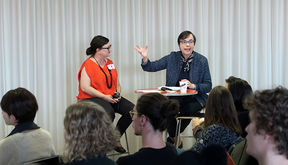Anne Stenros: From user experience towards citizen experience

The first-ever Chief Design Officer of City of Helsinki, Dr. Anne Stenros, occasionally describes herself as Chief Disruption Officer. She sees her role as a creative catalyst, who can encourage people to act now, with urgency, and change things for the better. It takes time for people to understand designers often forward-looking and ahead-of-time concepts and ideas, she says.
Anne Stenros shared her personal experiences for a group of 166 new design MA students coming from 34 different countries to the INTRO course organized by Aalto’s Department of Design. She was interviewed by Professor of New Frontiers in Design, Ramia Mazé.
Anne Stenros has worked for the private sector at KONE Corporation, the academic sector as a former professor at Aalto University, and the public sector, currently the City of Helsinki. Stenros explained that during recent years the design discussion has been going on around user and customer experience. However, she sees the future moving more towards citizen experiences as well as the idea of responsibility. Educating the mind with educating the heart is important for all designers and game-changers. “There exists a need for humanity also in the future. How can we survive as citizens of the world and be civil to one another?” she said.
The feeling of hope has always been important to young designers in creating impact, Stenros said. It is up to oneself to think about what kinds of experiences a designer hopes to engage into and as a result, to achieve. Stenros spoke about different understandings of time and time scales, as well as varied sense of urgencies, as something to be taken into consideration when designing with and for the people coming from various sectors and networks.
Chief Design Officer, Dr. Anne Stenros (on the left) and Head of Governance Mikko Annala. Photo: Emilija Veselova.
“Design leadership in general is mostly self-leadership”, shared Stenros. “A role, such as Chief Design Officer, is the headline only. You have to fill in the whole picture, who you yourself are as a designer and as a person. Especially if you do pioneering work. This is the core competence. One should also think one’s skillset and how to continuously widen it. Question yourself, do you work for money or whatever else makes you tick?” Stenros stressed widening one’s skillset during one’s career “cycle”. A designer’s career can no longer be merely understood as a straight path but instead of as a cycle of events and incidents where designer can change projects and contexts of working and develop one’s skills accordingly. Forward-looking attitude and curiosity have always been the red thread of Stenros’s career.
In addition to this, skills for visualization, making things more tangible instead of presenting immaterial and abstract ideas, is crucial for a designer in the future too. It is also important to develop the ability to map future possibilities for navigation for others, such as scenarios or foresight-related ideas and themes. Stenros encourages students to read a lot, to get out from their comfort zones and to learn to understand other people’s perspectives. As a neo-generalist herself, she values mastering of multiple disciplines rather than just one’s own. As her final tips for all MA design students, she recommends to continuously make projects and plans for oneself. “Be ready to take the opportunity when you face it”, she encourages all. “Be courageous and jump right in! Just remember the importance of details.”
In addition to Anne Stenros, the new international design MA students also heard a presentation by Head of Governance Innovation Mikko Annala from Demos Helsinki. Annala described five megatrends, which will have a significant role on all designers’ working lives in the future: climate change, changing population, digitalization, global economy and post-individualism. Annala highlighted the importance of co-creation, foresight and experimentation in all levels together with citizen engagement in order for the designers to make – possibly – a great impact on the society both local and global level.
More information:
In the Department of Design at Aalto University, all incoming Master’s students start up with a common introductory course MUO-E000 INTRO which joins all students from across the 5 Master’s programs in design (Collaborative and Industrial Design, Creative Sustainability, International Design Business Management, Fashion, Clothing and Textile Design and Product and Spatial Design).
The course explores: “How do we, as designers, engage with societal challenges and change? How do you envision future design competencies, work practices and forms of organization?” In this course, and this year during Suomi100, we take a wide and forward-looking view of how design should be developed to address future societal and ecological challenges.
Teaching contacts:
Professor of New Frontiers in Design Ramia Mazé
PhD Candidate Anja-Lisa Hirscher
MA student in Collaborative and Industrial Design Emilija Veselova
Read more news

DeployAI Partners Gather for Heart Beat Meeting in Helsinki
The European DeployAI project's partners gathered for the Heart Beat meeting hosted by Aalto University Executive Education in Helsinki.
Online AI course could boost study equality
Students at the School of Business believe that mastering Artificial Intelligence (AI) can be beneficial for both academic success and career prospects, as AI becomes increasingly integrated into daily life.
2 027 new students admitted to Aalto University’s Finnish, Swedish bachelor’s programmes
13 500 applied to Aalto University in Finland's spring joint application in 2024